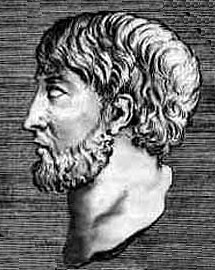Introduction | Life | Work

Anaximenes
|
|
Anaximenes (c. 585 - 525 B.C.) was an early Pre-Socratic philosopher from the Greek city of Miletus in Ionia (modern-day Turkey). He was a key figure in the Milesian School, a friend and pupil of Anaximander and he continued the Milesians' philosophical inquiries into the "archÍ" or first principle of the universe (which Anaximenes deemed to be air), and sought to give a quasi-scientific explanation of the world.
In the physical sciences, Anaximenes was the first Greek to distinguish clearly between planets and stars, and he used his principles to account for various natural phenomena, such as thunder and lightning, rainbows, earthquakes, etc.
Nothing is known of his life of Anaximenes (pronounced an-ax-IM-en-ees), other than that he was the son of Eurystratos of Miletus, and was the pupil or companion of Anaximander. Some say that he was also a pupil of Parmenides of Elea, although this seems unlikely. He lived for at least part of his life under Persian rule, and so he may have witnessed the Ionian rebellion against Greek occupation. There is some evidence from letters that he was in communication with Pythagoras, although any influence on Pythagoras' philosophical development was probably minor (other than the desire to explain the world in non-mythological terms).
According to Diogenes LaŽrtius (a biographer of the Greek philosophers, who lived in the 2nd or 3rd Century A.D.), Anaximenes wrote his philosophical views in a book, which survived well into the Hellenistic period, although nothing now remains of this.
Like the other Milesian philosophers before him, Anaximenes' main concern was to identify the single source of all things in the universe (Monism). Thales, the earliest Milesian, had taken this to be water. His pupil Anaximander refined this somewhat, arguing that no single element could adequately explain all of the opposites found in nature, and propounded the solution of an endless, unlimited primordial mass which he called "apeiron".
Anaximenes arguably took a step backwards by revisiting the notion that a single element was indeed the source of all things, and that element he deemed to be air (actually the Greek word "aer" also denotes "mist" or "vapour" as well as the normal air we breathe). He held that, at one time, everything was air, and that, even now, everything is air at different degrees of density. Since air is infinite and perpetually in motion, it can produce all things without being actually produced by anything.
Under the influence of heat (which expands it) and of cold (which contracts it), and the associated processes of rarefaction (air separating) and condensation (air coming together), air gradually gives rise to the several phases of existence and all the materials of the organized world. Anaximenes believed that air came in threads which came together by a process called "felting", analogous to the process by which wool is compressed to make felt. Thus, very close air was a solid, less close a liquid, etc.
In this way, therefore, Anaximenes used natural processes familiar from everyday experience to account for material change and, in this respect at least, his theory was an advance over those of Thales and Anaximander.
According to Anaximenes, the earth is a broad disk, floating on the circumambient air. The sun and stars, he held, were formed by the same processes of condensation and rarefaction, and the flaming nature of these bodies is merely due to the velocity of their motions. He also used his principles to account for various natural phenomena: thunder and lightning result from wind breaking out of clouds; rainbows are the result of the rays of the sun falling on clouds; earthquakes are caused by the cracking of the earth when it dries out after being moistened by rains; hail is a result of frozen rainwater; etc.
Anaximenes also equated the first material principle with the divine, so that effectively "air is God", both being infinite and eternal. Thus, the pantheon of Greek gods were merely derivations of the truly divine, air. Similarly, the souls of individuals were also composed of air (or breath), and hold us together in the same way as air encompasses the entire world.
|
|
